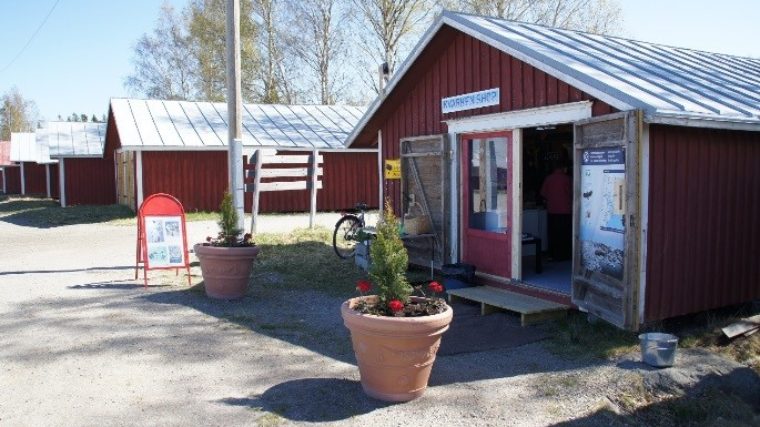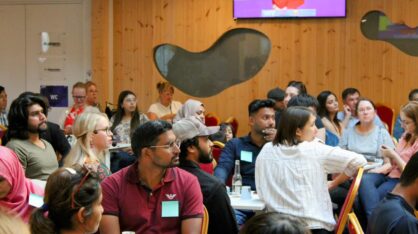As craft entrepreneurs, Kvarken Shop’s owners confronted several challenges. First is the challenge of selling own products in a more customer-oriented price without an added retail-sales percentage and lowering the quality of the products. This led to sub-challenges of (1) developing a functional business model, (2) running everyday activities, (3) developing and innovating products, (4) finding new customers, and (5) foreseeing customer flows.
Developing a functional business model and everyday operation
The product range is based on the group’s selection, and certain external items were also included to round out the offer. These include art pottery, woollen and silk items, silver and glass objects, paintings, knitwear and handicraft, wood works, and natural cosmetics, as well as publications about local Björköby cupboard makers. Local islander bread and tinned lamb meat are occasionally available. The personnel wear traditional outfits and tell stories that spark the curiosity of the customers.
Other activities include the organisation of TYKY-days (work activity days), collaboration with local tourist guides on how tourists move around the area, considering the local post rowing event between Vaasa and Umeå in June 2019, advertising transportation of 800 sheep to the archipelago for the summer months, visits from various associations, and hundreds of tourist buses and caravans in a parking area. Tourist information, on the other hand, has evolved into an extra activity of Kvarken Shop. It brings in more clients and has become a component of the company strategy. As a result, the shop has become a type of reference point, where one can even buy water, grab an umbrella, and begin one of the hiking trails.
Those activities demonstrate a versatility to the regional business structure, which have been grounded on the local culture, cultural heritage and sustainability. In order to run these activities at the shop, the group has agreed on work shifts. Staff are skilled and professionals on their own. They are energetic and thrilled while raising knowledge of the region, its history, and ancient legends, as well as the local museum, the Saltkaret tower, and information on the rising land.
Developing and innovating products
Customer feedback and needs are the primary drivers of product creation and innovation, as well as business model innovation. Aside from spoken materials, constructed circumstances and the guest book have also been used. For example, the demands of travellers (water, information after usual tourist information is closed, etc.) were considered when developing the activity. As a result, this is an example of developing and improving a business model and activity based on customer-understanding, within quick experimentation and user-orientation. The basic business model allows Kvarken Shop a flexibility to modify activities when needed, as well as the ability to make things by hand in a timely and consistent manner.
Finding new customers
Various low-budget methods of attracting customers have been used, including collaboration with local actors, social media, events, boat trips to two islands (Valassaari and Mikkelinsaari), bird watchers, tourists, and Sunday family trips, and bringing authenticity and warmth with traditional outfits and stories.
The group has utilised a solid understanding of their customers as a foundation for attracting new customers and attaining existing ones. Due to the COVID-19, foreign tourists were replaced by domestic customers who purchased different products than international tourists. Locality brought customers and product supplement was ensured to comprise the local products (e.g. seabucktorn juice and jam and grill oils, camping coffee of a roasting house from Vaasa and wool/sheep products). Besides, customers who wish to possess things reminding them of travelling places were also considered in product assortments.
At Kvarken Shop, other customer-oriented modes of operation and additional services are believed to bring new customers as well. A service-oriented attitude, such as acting as a tourist information point, provides customers with outstanding experiences, and, as a result, can bring in new customers.
Foreseeing customer flow
The following things are observed and responded upon in order to predict and react on consumer flow:
- follow-up with guests and responses to guest book comments
- responding promptly to feedback when available
- daily sales tracking
- collaboration with Vaasa-Mustasaari tour guides
- collaboration with Visit Vaasa (arrival with tourist busses)
Listening to consumers – customer-orientation, quick reaction and reorienting the activity, rapid trials, storytelling, and collaboration with stakeholders have been the major methods for increasing innovation applied to company model and process in this approach.
The Bottom Line
Kvarken Shop is an ideal example of a fully craftspeople-led business that takes risks of their own shop and achieves their success. The shop has utilised a solid understanding of customers – customer-orientation empathy, quick reaction and reorienting the activity, rapid trials, storytelling, and collaboration with stakeholders, as a core of their business development and product innovation.
Kvarken Shop has successfully integrated the local culture, cultural heritage and sustainable dimensions into their business. This operation is easily adaptable to any location where people travel and there are only few services. The premises did not necessitate a large investment, in which creativity can be a key to achieve desirable outcomes.




